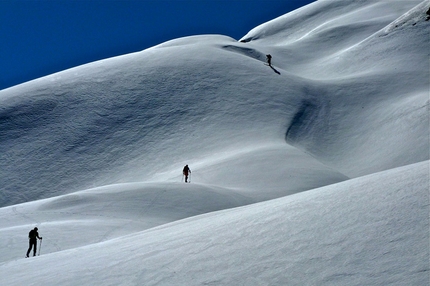The Apuan Alps are a small mountain range in Italy's northern Tuscany. It runs parallel to the nearby Apennines and is separated by a single, broad valley called Garfagnana. On the other side, towards the south-west and lying at the foot of these peaks, is a narrow, densely populated strip of land called Versilia that then gives way to the Tyrrhenian Sea.
The contrast between the Apuan Alps and the nearby Apennines is stark. The two ranges are clearly visible from Lunigiana (the broad valley with river Magra): to the East the Apennines resemble an imposing bastion where no peak stands out particularly, while to the West, the Apuan Alps are a constellation of sharp, severe summits, each with a distinctive shape and personality.
Comprised mostly of compact rock (the famous white marble that contributed in making them famous and which is also the cause of the continuous, relentless quarrying) in summer the Apuan Alps lend themselves to pleasant rock climbing, especially on the excellent limestone of the lower peaks. It is in the winter however that these mountains transform into something quite unique: their proximity to the sea makes the very wet snow stick to the rock, even at unthinkable angles, thereby creating mixed routes that have no parallels in terms of commitment, continuity and beauty.
Since these mountains are generally very steep and rocky, they lend themselves more to mountaineering than to ski mountaineering. Apart from a handful of classic ski tours, ski mountaineering in the Apuan Alps is decidedly "alpine" and, to reach the summits, crampons are often used far more skis and climbing skins.
The views are quite unique and you certainly won't be disappointed. It's strange, after having two days spent on a cold shadowy face, or after having struggled up a north gully with skis strapped to your rucksack, to suddenly be up there, on a knife-edge ridge overlooking the Mediterranean Sea to soaking up the heat of two suns, one in the sky and one mirrored in the sea, before skiing down to the sea to smell the scent of thyme and myrtle. On more than one occasion, in particular in March, I've actually gone for a quick dip in the sea after having skied from Monte Sagro...
| Name |
Grade |
Height difference |
| Monte Tambura: la Carcaraia |
MSA |
1050m |
Monte Tambura is certainly the easiest summit in the Apuan Alps. It's a sort of large pyramid with a triangular base formed by three ridges and its three sides. The North Face is called Carcaraia and is less steep than the other two: being karst, it is virtually devoid of gullies but instead full of hollows and jumbled depressions that need to be entered and surmounted as best possible. In good snow conditions this is a highly respectable summit, the surrounding beautiful and the panorama, as usual, quite magnificent. Unfortunately Tambura is also famous for its high altitude quarry at Passo della Focolaccia which cut into the watershed ridge and consequently modified the Apuan "skyline". The proposed itinerary steers well clear of this mess. For those who prefer to confront with the pain of knowledge and understanding, I recommend the variantion ring route.
|
| Monte Sagro |
BSA, 3.1/E1 (Ovest)
OSA, 4.1/E2 (Nord-Ovest ) |
100m + 450m + 500m |
Sagro is the mountain in the Apuan Alps that is the closest to the sea. From the sea it resembles a large grassy blade, and its color varies according to the seasons: green in spring, yellow in summer and autumn, white in winter. Actually, in the winter it isn't always pure white. Snow comes and goes depending on the snowfall, temperature, rainfall, wind, etc.. and it's therefore a mountain that needs to be climbed at just the right moment, and that quickly comes into condition after a snowfall. Given the modest height difference I recommend combining its two skiable slopes, the classic West Face normal route with the more difficult NW Face. The west side is usually docile and sunny, while the North-West Face, especially in the morning, contrasts with its shadows and severe nature that, despite the short, easily accessible slope, inspires a certain awe. Due to the proximity to the sea and to the angle of its lower slopes, the descent down the west face is particularly striking.
|
| Monte Pisanino - Canale delle Rose |
4.3/E3 |
850m (1100 the variation) |
| Monte Pisanino is the highest mountain in the Apuan Alps and, especially in winter, is impressive from any side you look at it. Its southern flank is mostly rocky and is criss-crossed by several gullies often broken by narrow sections, steep steps or slabs. The descent described here is an "alpine" undertaking, and to ski it you need to look for the easy with the difficult, following an illogical sequence of bands of snow, not too steep, that are linked together. The slope angle is constant but never extreme and in some short sections reaches 50°. The route takes you past different aspects (first south, then north-east, then west, then north-west and finally west again), resulting in an exposed and challenging descent. Finding optimal conditions along the whole route is by no means easy but it's well worth the effort. |
|
HOW TO GET THERE
From Parma: follow the motorway A15 towards La Spezia
From Genova: follow the motorway A12 towards Livorno
From Firenze: follow the motorway A11 towards Viareggio
From Rome: follow the state road Aurelia to Rosignano then take the motorway A12 towards Genova
by Giampaolo Betta, Mountain Guide
email: info@wbguides.com

 1 / 12
1 / 12 Giampaolo Betta
Giampaolo Betta



 Copia link
Copia link









 See all photos
See all photos






















